Elevating Public Perception and Reducing Complaints: The Power of Accessible Customer Communications
With ineffective communication ranking as one of the top complaints among customers, it’s crucial for managers and leaders to recognise the profound impact that accessible customer communications can have on shaping public opinion and minimising grievances.
Why Ineffective Communication is a Major Challenge
It comes as no surprise that ineffective communication consistently ranks as one of the top complaints from customers. Unclear or inaccessible message can breed frustration, erode trust, and tarnish your reputation. In fact, studies have shown that it’s often the first or second most common complaint, acting as a glaring red flag that must not be ignored.
The Ripple Effect of Accessible Customer Communications
On the flip side, when organisations prioritise accessible customer communications, the benefits are multifold. Here’s how it positively impacts public perception and paves the way for a reduction in complaints:
-
- Enhanced Trust and Credibility: Clear and accessible communication fosters trust between you and your customers. When information is easily understood and readily available, customers feel valued and respected, leading to a stronger bond between them and your brand.
-
- Positive Reputation: In the digital age, news travels fast, and a satisfied customer is more likely to share their positive experiences. Accessible communication ensures that customers can easily obtain the information they need, reducing the chances of misunderstandings and negative word-of-mouth.
-
- Empowerment and Inclusivity: By embracing accessible communication channels, you empower a diverse range of customers to engage with your organisation. This inclusivity not only resonates with customers but also showcases your commitment to social responsibility.
-
- Faster Conflict Resolution: Accessibility allows for quicker resolution of issues. When customers can easily voice their concerns and receive timely responses, it minimises frustration and escalations, resulting in a more positive customer experience.
-
- Cultivating Brand Advocates: Satisfied customers who experience accessible communication are more likely to become loyal advocates for your brand. These advocates can play a pivotal role in bolstering your image, and attract new, loyal customers.
Taking Action: Steps to Improve Customer Communications -
- Audit Current Communication Channels: Begin by assessing your current communication channels and identifying areas for improvement. Are your messages clear, concise, and easily understood? Are you providing multiple avenues for customers to reach out? We have a free audit framework available -just ask!
-
- Invest in Technology: Leverage technology to enhance accessibility. Your digital and physic presence can be enhanced support the accessibility requirements of your customers. Even printer media such as posted letters and static signs can be used to deliver digital channels without the need to install screens.
-
- Training and Education: Equip your customer service teams with the skills and knowledge to communicate effectively. Invest in ongoing training that emphasises active listening, empathy, and clear communication. For example, is everyone involved in public communications deaf aware and undestand why written words, such as captions or subtitles often are inappropraite?
-
- Multilingual Support: In a global marketplace, offering multilingual support is essential. Consider providing resources and personnel who can cater to customers’ preferred languages.
-
- User-Friendly Documentation: Ensure that your product manuals, FAQs, and other resources are user-friendly and easily accessible. Avoid jargon and complex language.
Accessible customer communications are not just a technicality
Reaching your customers with communications they understand is the cornerstone of a positive customer experience. By prioritising clear, inclusive, and timely communication, managers and leaders in large organisations can significantly enhance public perception, cultivate brand loyalty, and mitigate the number of complaints. Remember, the path to success is paved with the wor\ds you choose and the ease with which you deliver them.
Enhancing Inclusivity: Elevating Deaf Awareness
In the pursuit of operational excellence and social responsibility, it is imperative for large organisations, especially those within sectors such as telecommunications and government, to embrace comprehensive inclusivity measures. This entails a dual commitment to fostering internal accessibility while equipping employees to address the needs of a diverse customer base, particularly individuals with hearing impairments.
Recent demographic statistics underline the significance of this initiative. Approximately one in five adults across the UK grapple with varying degrees of hearing loss or are Deaf, underscoring the prevalence of this demographic. Invariably, within your workforce and customer pool, you are likely to engage with individuals who encounter communication challenges stemming from hearing impairment.
It is pivotal to recognize that these communication hurdles extend beyond the auditory domain. The realm of written text can pose difficulties for Deaf and hard of hearing individuals, accentuating the need for an encompassing approach to Deaf Awareness.
A proactive measure in this regard involves imparting Deaf Awareness training to your personnel. This educational initiative encompasses foundational comprehension of British Sign Language (BSL), the primary mode of communication for many Deaf individuals. By instilling a basic proficiency in BSL within your staff, you effectively bridge the communication gap that often isolates those with hearing impairments.
Embracing Deaf Awareness not only enhances internal cohesion and inclusivity but also augments your external customer interactions. Armed with the ability to accommodate Deaf and hard of hearing customers, you extend a welcoming embrace to a previously underserved demographic. This resonates positively, not only in terms of public perception but also in terms of business growth and sustainability.
Embedding Deaf Awareness within your organisation signifies a commitment to accessibility and social equity. By facilitating internal accessibility measures and equipping your staff with Deaf Awareness training, including rudimentary BSL skills, you are poised to expand your customer base, fortify public perception, and bolster your organisational success.











